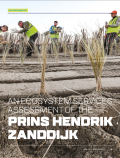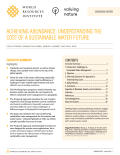This report provides a high-level summary of the research on corporate action on WASH in supply chains. It provides key findings and recommendations for the practice and policy community. Case studies accompany this report and detail how companies are taking action.

This study examines which and, if possible, how much more ecosystem services are provided by the most recent nature inspired coastal protection project Prins Hendrik Zanddijk, in comparison with a traditional concrete and asphalt construction.

This Paper proposes a method whereby any decision-maker can calculate the cost required to deliver sustainable water management to a geography. It calculates the cost of action required to close the gap between current conditions and desired conditions to financially compare and prioritize different water-related challenges or different targets of Sustainable Development Goal 6. The paper also estimates the costs of delivering sustainable water management for all countries and major basins.

This policy brief explores how integrated ecosystem-based management in marine areas beyond national jurisdiction can be advanced at the regional level and how the BBNJ Agreement (“international legally binding instrument for the conservation and sustainable use of marine biodiversity in areas beyond national jurisdiction") can build on experiences in other legally binding agreements to strengthen regional cooperation, coordination and coherence.

This study, which calculates the economic cost of nature’s decline across 140 countries, shows that the loss of six ecosystem services under a business-as-usual trajectory leads to losses of US$9.87 trillion in real GDP by 2050. This represents an annual loss of US$479 billion per year. In contrast, under a scenario in which land-use is carefully managed to avoid further loss of areas important for biodiversity and ecosystem services, economic outcomes would be dramatically better, with global GDP rising by $490 billion per year above the business-as-usual calculation.
